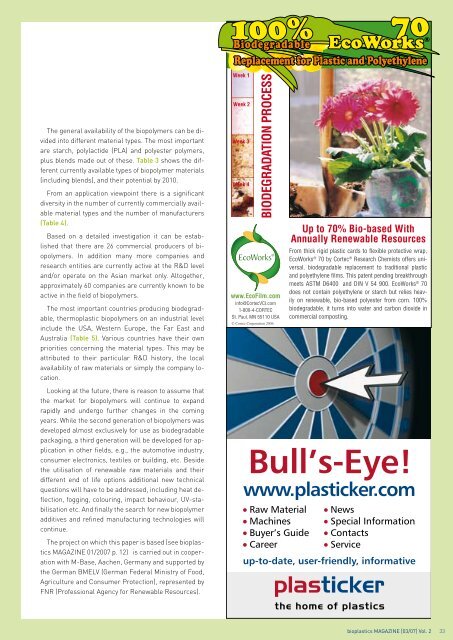bioplasticsMAGAZINE_0703
bioplasticsMAGAZINE_0703
bioplasticsMAGAZINE_0703
Create successful ePaper yourself
Turn your PDF publications into a flip-book with our unique Google optimized e-Paper software.
The general availability of the biopolymers can be divided<br />
into different material types. The most important<br />
are starch, polylactide (PLA) and polyester polymers,<br />
plus blends made out of these. Table 3 shows the different<br />
currently available types of biopolymer materials<br />
(including blends), and their potential by 2010.<br />
From an application viewpoint there is a significant<br />
diversity in the number of currently commercially available<br />
material types and the number of manufacturers<br />
(Table 4).<br />
Based on a detailed investigation it can be established<br />
that there are 26 commercial producers of biopolymers.<br />
In addition many more companies and<br />
research entities are currently active at the R&D level<br />
and/or operate on the Asian market only. Altogether,<br />
approximately 60 companies are currently known to be<br />
active in the field of biopolymers.<br />
The most important countries producing biodegradable,<br />
thermoplastic biopolymers on an industrial level<br />
include the USA, Western Europe, the Far East and<br />
Australia (Table 5). Various countries have their own<br />
priorities concerning the material types. This may be<br />
attributed to their particular R&D history, the local<br />
availability of raw materials or simply the company location.<br />
Looking at the future, there is reason to assume that<br />
the market for biopolymers will continue to expand<br />
rapidly and undergo further changes in the coming<br />
years. While the second generation of biopolymers was<br />
developed almost exclusively for use as biodegradable<br />
packaging, a third generation will be developed for application<br />
in other fields, e.g., the automotive industry,<br />
consumer electronics, textiles or building, etc. Beside<br />
the utilisation of renewable raw materials and their<br />
different end of life options additional new technical<br />
questions will have to be addressed, including heat deflection,<br />
fogging, colouring, impact behaviour, UV-stabilisation<br />
etc. And finally the search for new biopolymer<br />
additives and refined manufacturing technologies will<br />
continue.<br />
The project on which this paper is based (see bioplastics<br />
MAGAZINE 01/2007 p. 12) is carried out in cooperation<br />
with M-Base, Aachen, Germany and supported by<br />
the German BMELV (German Federal Ministry of Food,<br />
Agriculture and Consumer Protection), represented by<br />
FNR (Professional Agency for Renewable Resources).<br />
Week 1<br />
Week 2<br />
Week 3<br />
Week 4<br />
BIODEGRADATION PROCESS<br />
EcoWorks ®<br />
www.EcoFilm.com<br />
info@CortecVCI.com<br />
1-800-4-CORTEC<br />
St. Paul, MN 55110 USA<br />
© Cortec Corporation 2006<br />
70®<br />
100%<br />
Biodegradable EcoWorks<br />
Replacement for Plastic and Polyethylene<br />
Up to 70% Bio-based With<br />
Annually Renewable Resources<br />
From thick rigid plastic cards to fl exible protective wrap,<br />
EcoWorks ® 70 by Cortec ® Research Chemists offers universal,<br />
biodegradable replacement to traditional plastic<br />
and polyethylene films. This patent pending breakthrough<br />
meets ASTM D6400 and DIN V 54 900. EcoWorks ® 70<br />
does not contain polyethylene or starch but relies heavily<br />
on renewable, bio-based polyester from corn. 100%<br />
biodegradable, it turns into water and carbon dioxide in<br />
commercial composting.<br />
EcoWorks BioPlastic.indd 1 8/2/06 8:44:40<br />
bioplastics MAGAZINE [03/07] Vol. 2 33


















